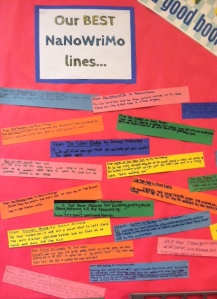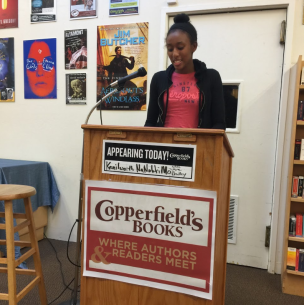 If your students are feverishly writing novels as fast their little fingers can fly across the keyboards, anxious to meet their NaNoWriMo word goals by the end of November, you may be wondering how best to assess their work during this glorious month of literary abandon. Since it may be unrealistic for you to read the complete texts of their novels (I have 98 students writing an average of 15,000 words each, so I don’t plan to read them all cover to cover), I offer you these more realistic assessments:
If your students are feverishly writing novels as fast their little fingers can fly across the keyboards, anxious to meet their NaNoWriMo word goals by the end of November, you may be wondering how best to assess their work during this glorious month of literary abandon. Since it may be unrealistic for you to read the complete texts of their novels (I have 98 students writing an average of 15,000 words each, so I don’t plan to read them all cover to cover), I offer you these more realistic assessments:
- have them choose one beautiful line from their writing to be shared publicly (on a blog, on a bulletin board, etc.). If you’d like to make it a more specific assessment, direct them to choose a line with a particularly effective metaphor or powerful imagery.
- give them a grade for making it to their individual goals by November 30. If they don’t make it, give them the percentage that they do achieve. Consider rewarding students who choose but don’t quite make it to an unusually high goal.
- once November is over, have students pull one-two page excerpts that demonstrate certain aspects of narrative writing: dialogue, character development, setting description, conflict, etc., and give them directions for revising those excerpts. Imagine the joy of grading just those short pieces that they have had time to fully polish, rather than tackling pages and pages that they won’t have time to revise.
- assign literary analysis of their own writing. My students have done some work analyzing why an author chose certain words or created certain characters; think of how powerful it would be for them to write analysis of their own novels. These shorter pieces would also be great on a blog so that students can respond to one another’s work.
- add public speaking to the experience. Our local bookstore hosted my students as visiting authors, and the work they did to prepare for that event was an assignment worthy of its own grade. They wrote an introduction of their novels, including tit
 le, genre, basic set up and themes; then they wrote an introduction of the excerpt so that the audience would understand it in context; and then they practiced reading aloud so that their work could be appreciated. The evening event was listed by many of my students as one of their favorite parts of the project, even though most of them said they were terrified of speaking in public.
le, genre, basic set up and themes; then they wrote an introduction of the excerpt so that the audience would understand it in context; and then they practiced reading aloud so that their work could be appreciated. The evening event was listed by many of my students as one of their favorite parts of the project, even though most of them said they were terrified of speaking in public. - extensions of the NaNoWriMo experience could include creating book trailers for their novels; book jackets with author information and critics’ quotes; posters with images and quotes from the text; and of course polishing their novels so they can take advantage of the free publication offered to them from CreateSpace.
The month-long journey of writing a lengthy story is valuable all by itself. Don’t work yourself too hard or put unnecessary stress on your students by trying to evaluate too much of what they have written. Focus on the beauty of smaller pieces and celebrate your students’ accomplishments as NaNoWriMo winners!

